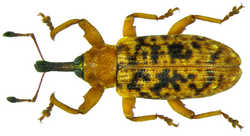Biology:Dorytomus taeniatus
| Dorytomus taeniatus | |
|---|---|

| |
| Dorytomus taeniatus 3-4,5 mm | |
| Scientific classification | |
| Domain: | Eukaryota |
| Kingdom: | Animalia |
| Phylum: | Arthropoda |
| Class: | Insecta |
| Order: | Coleoptera |
| Infraorder: | Cucujiformia |
| Family: | Curculionidae |
| Subfamily: | Curculioninae |
| Genus: | Dorytomus |
| Species: | D. taeniatus
|
| Binomial name | |
| Dorytomus taeniatus (Fabricius, 1781)[1]
| |
Dorytomus taeniatus is a species of weevil native to Europe.[2][3] It was first described by Johann Christian Fabricius in 1781. The larvae cause a small growth (known as a gall) on the catkins of willows (Salix species).
Description
Eggs are laid during the autumn in the axils of catkin buds and hatch the following spring.[4] The larvae cause an inconspicuous distortion of, usually, female catkins, thickening the rachis.[5] Catkins drop earlier than uninfected catkins and the larvae pupate in the soil.[6] Close examination of the gall is necessary as Redfern et al. (2011) note that sometimes, thickening of the rachis can be wound tissue rather than a gall and according to Plant Parasites of Europe identification is only possible by examining the weevils.[5][6]
The gall has been recorded from white willow (S. alba), eared willow (S. aurita'), goat willow (S. caprea), grey willow (S. cinerea) and purple willow (S.purpurea).[6]
Adults are 4–5 millimetres (0.16–0.20 in) long and brownish-black to black. They can be found from May onwards, browsing on the leaves, removing patches of tissue and exposing the network of fine veins.[4]
Distribution
Found in western and central Europe including Great Britain (common) and Scandinavia.[7]
References
- ↑ Fabricius, J.C. 1781. Species insectorum; exhibentes eorum differentias specificas, synonyma, auctorum, loca natalia, metamorphosin ediectis observationibus, descriptionibus. Carol. Ernest. Bohnii, Hamburgi et Kilonii
- ↑ Morris, M.G. (2012) True Weevils. (Coleoptera: Curculioninae, Baridinae, Oroitidinae). Part III. Royal Entomological Society of London Handbook 5 (17d).
- ↑ Hoffmann, A. (1950, 1954, 1958) Coléoptères curculionides. Parties I, II, III. Paris: Éditions Faune de France. Bibliothèque virtuelle numérique pdfs
- ↑ 4.0 4.1 Alford, David V (2012). Pests of Ornamental Trees, Shrubs and Flowers: A Color Handbook. Waltham: Academic Press. p. 155. ISBN 978-0-12-398515-6. https://books.google.com/books?id=c9PwiScwmPIC&q=Dorytomus+taeniatus&pg=PA155.
- ↑ 5.0 5.1 Redfern, Margaret; Shirley, Peter; Boxham, Michael (2011). British Plant Galls (Second ed.). Shrewsbury: Field Study Council. pp. 282–299. ISBN 978-185153-284-1.
- ↑ 6.0 6.1 6.2 Ellis, W N. "Dorytomus taeniatus (Fabricius, 1781)". https://bladmineerders.nl/parasites/animalia/arthropoda/insecta/coleoptera/polyphaga/cucujiformia/curculionoidea/curculionidae/curculioninae/ellescini/dorytomus/dorytomus-taeniatus/. Retrieved 11 July 2019.
- ↑ "Dorytomus taeniatus". https://eol.org/pages/395017. Retrieved 11 July 2019.
Wikidata ☰ Q15736525 entry
 |

